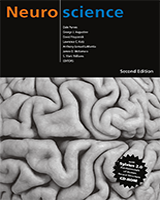By agreement with the publisher, this book is accessible by the search feature, but cannot be browsed.
NCBI Bookshelf. A service of the National Library of Medicine, National Institutes of Health.
Purves D, Augustine GJ, Fitzpatrick D, et al., editors. Neuroscience. 2nd edition. Sunderland (MA): Sinauer Associates; 2001.

Neuroscience. 2nd edition.
Show detailsThe cochlear hair cells in humans consist of one row of inner hair cells and three rows of outer hair cells (see Figure 13.4). The inner hair cells are the actual sensory receptors, and 95% of the fibers of the auditory nerve that project to the brain arise from this subpopulation. The terminations on the outer hair cells are almost all from efferent axons that arise from cells in the brain.
A clue to the significance of this efferent pathway was provided by the discovery that basilar membrane motion is influenced by an active process within the cochlea, as already noted. First, it was found that the cochlea actually emits sound under certain conditions. These otoacoustical emissions can be detected by placing a sensitive microphone at the eardrum and monitoring the response after briefly presenting a tone. Such emissions can also occur spontaneously. These observations clearly indicate that a process within the cochlea is capable of producing sound. Second, stimulation of the crossed olivocochlear bundle, which supplies efferent input to the outer hair cells, can broaden eighth nerve tuning curves. Finally, isolated outer hair cells move in response to small electrical currents, apparently due to the transduction process being driven in reverse. Thus, it seems likely that the outer hair cells sharpen the frequency-resolving power of the cochlea by actively contracting and relaxing, thus changing the stiffness of the tectorial membrane at particular locations. An active process of this sort is necessary in any event to explain the nonlinear vibration of the basilar membrane at low sound intensities (Box B).
- Two Kinds of Hair Cells in the Cochlea - NeuroscienceTwo Kinds of Hair Cells in the Cochlea - Neuroscience
Your browsing activity is empty.
Activity recording is turned off.
See more...